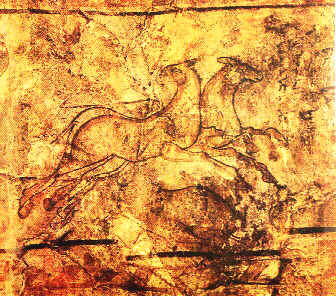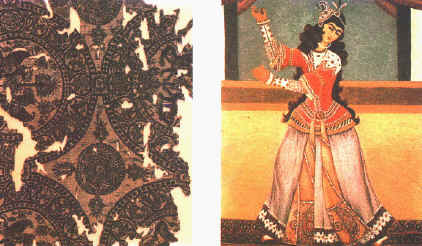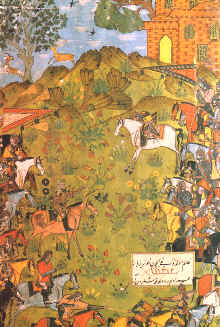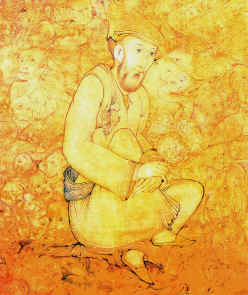The Art of Painting
"Iran has offered a particularly unique art to
the world which excellent in its kind"; Basil Gray
The history of the art of painting in Iran, goes back to the cave age. In the caves of
"Lorestan" province, painted images of animals and hunting scenes have been
discovered.
Paintings discovered by W. Semner, on the walls of buildings, in Mallyan heights, in Fars, belong to 5,000 years ago.
Paintings discovered on earthenware in "Lorestan", "Sialk", and other archaeological sites, prove that the artists of this region were familiar with the art of painting.
Also from the Ashkani era (parts), few mural paintings, most of them discovered in the northern parts of "Forat" river, have been uncovered. One of these paintings is a display of a hunting scene. The position of riders and animals, and the style in this work reminds us of the Iranian miniatures.
In the paintings of Hakhamaneshi era, profile work was preferred by the artists. The proportion and beauty of colors of this era, are remarkable. The colors are shadeless, and have the same tune. In some cases, black stripes limited the colorful surfaces.
Mani, the Iranian painter, who lived about the 3rd century, was a skilled and expert painter. His paintings were thought to be part of his miracles.
The paintings of "Torfan", discovered in the desert of "Gall", a region situated in the Turkistan province in China, belong to 840 to 860 AD.
These mural paintings exhibit Iranian scenes and portraits. Images of tree branches also exist in these paintings. The most ancient paintings of the Islamic periodic, are quiet scarce, and were created in the first half of the 13th century. Iranian miniatures (fine and small drawings) came to Fife after the fall of Baghdad (1285 AD). Since the beginning of the 14th century, handwritten books were adorned by the scenes from battle fields, feasts and hunting.

China, perhaps since the 7th century, as an artistic center, has been the most important incentive for the art of painting in Iran. Ever since, a relation has been established between Buddhist Chinese painters and, Iranian artists.
From the historic viewpoint, the most important evolution in Iranian art, has been the adoption of Chinese designs and coloring which were mixed with the specific conception of Iranian artists. The extreme beauty and skill of Iranian paintings are laid to describe. In the first centuries, after the emergence of Islam, Iranian artists began adorning books.
The preface and the margins of books were adorned with. These designs were passed on, through on to the next centuries, together with precise principles and rules, which is known as the "Art of Illumination".
The art of illumination and adorning books made its path of progression under the Saljooghi, Mogol and Teimoor's reigns.
Paintings from the beginning of the Islamic period had the reputation of belonging to Baghdad school.
Miniatures of Baghdad school, have totally lost the style and methods of the usual paintings of the pre-Islamic period.
These primitive and innovative paintings do not possess the necessary artistic stress. The miniatures of Baghdad school are not proportional. Portraits show the "Sami" race and light colors are used. Artists of the Baghdad school, after years of stagnancy', were eager to create and innovate. The particular views of this school, is in drawing animals and illustrating stories.
Although the Baghdad school, considering the pre-Islamic art, is to some extent, superficial and primitive, but the art of Iranian miniature, in the same period, was widespread in every region in which, Islam was propagated: Far East, Africa and Europe.
Among illustrated books in the Baghdad style, "Kelileh and Demneh" can be named. Images are painted larger than normal and are not proportional. Only few colors are used in these paintings.
Most of the handwritten books of the 13th century are enriched with images of animals, vegetables and illustrations from fables and stories.
An example of the most ancient Iranian miniature is the drawings of a book called: "Manafe-alHayvan" (1299 AD). This book describes the characteristics of animals. The natural history is mixed and narrated through the ancient fables in this book.
Diverse subjects of this book, require numerous images which are So important in familiarizing the reader with the Iranian art of painting. Colors are bright and laying step after the old style of the Baghdad school.
|
|
|
|
After the invasion of Mogols, a new school appeared in Iran. This school was totally under the influence of the Chinese and Mogul style. These paintings are all minute, dry, motionless and pure, in the Chinese style.
Mogul emperors, after the invasion of Iran, were impressed by the Iranian art and encouraged the painters, initiating the former kings of Iran.

Among the characteristics of the Iranian art which can also be observed in the paintings of Mogul style, we can enumerate, subtleties, decorative compositions, and fine short lines. The style of the Iranian paintings is linear and not dimensional. Artists in this field have demonstrated a particular creativity and genuineness.
Artists of the Mogul royal court honored not only the techniques but also Iranian themes. A part of their work consisted of illustrating Iranian literary masterpieces such as: "The Shahnameh" of Ferdowsi. Among the themes, portraitism was of utmost interest.
Contrary to Baghdad and Mogul schools, more works remain from Harat school. The founders of the style of painting called the Harat school, were Teimoor's ancestors, and the school was named after the place in which it was founded.
Art experts believe that during Teimoor's era, the art of painting in Iran, had reached a climax. During this period, outstanding masters, such as: Kamal-ul-Din Behzad, contributed a new touch to the Iranian painting. The Temoorian period continued from 1370 to 1405 AD In this period, the art of miniature and book illumination, reached the highest degree of progression, and most famous painters gave life to their work in this period.

There remains 2 valuable illustrated books from the reign of Baisongor. One, being the "Kelileh and Demneh' and the other, "Baisongor's Shahnameh" (epic of kings). In the drawings of "Shahnameh", painted in 1444 AD in Shiraz, interesting examples of Iranian miniature art can be seen.
One of these drawings represents a beautiful scene from an Iranian court, painted in the Chinese style. White and blue tiles and Persian carpets are drawn in geometrical shapes.
In one of the manuscripts of the book of "Khamseh Nezami", exist 13 excellent miniatures, drawn by "Mirak", the famous painter and calligrapher.
The antificeless, sensitive, and artistic spirit of Baghdad's paintings are represented in the drawings of another volume among the works of "Khamseh Nezami".
This precious work is preserved in "Britannia Museum". One of the liveliest paintings of this book, shows the construction of "Jozanag" palace.
In this painting, masters and architects are busy building the palace. This miniature was painted in 1494 in Harat.
Behzad, the greatest painter of the Harat School, expanded the delicate art of miniature. He invented new patterns for natural facts and portraitism which did not exist before his time.
One of the masterpieces of the Iranian art of painting is an illustrated book of "Shahnameh", preserved in the library of "Golestan" palace in Tehran.
This "Shahnameh" was also illustrated under Baisongor. the Teimoorian prince, and belongs to the Harat School.
The paintings of this book, from the view point of coloration and the proportion of the components in the images are at the highest degree of beauty and firmness.
During the Safavi era, the artistic center was moved to Tabriz. A few artists also settled in Qazvin. But the Safavi School of painting was established in Isfahan.
The miniature of Iran, in the Isfahan of Safavi era, was detached from the influence of the Chinese out and stepped on a new road. The painters were then more inclined towards naturalism.
Reza Abbassi, founded the "Safavi School of painting". The art of design during the Safavi era subjected to a brilliant transformation.
The design, which is one of the most elegant Iranian designs, was made possible by the talent of the artists of the Safavi School. Miniatures created under the Safavi School, were not exclusively aimed for adorning and illustrating books. The Safavi style is softer in form than those of the Teimoorian School, specially the Mongolian. Human images and their behavior are not vain and artificial, in the contrary quiet natural, and close to reality.
Safavi painters also manifested a special expertness in heural paintings. The most magnificent example of the hueral paintings of this period exists in the palaces of "Chehel Sotoon" and "Ali Qapoo".
In Safavi paintings, the splendor and the grandeur of this period is the main attraction. The themes of the paintings &e about the life in the royal court, the nobles, beautiful palaces, pleasant goodness, scenes of battles and banquets.
Humans are drawn in sumptuous garments, handsome faces and elegant statues colors are glowingly bright.
The art of painting, during the Safavi era
expanded both in quantity and quality. In the works of this period, a greater freedom,
skill, and power can be seen.

Artists paid more attention to generalities and, avoided unnecessary details, as used in Harat and Tabriz styles. The smoothness of lines, the quick expression of feelings, and condensing the subjects are the characteristics of the Safavi style of painting. Since the end of the Safavi era, perspective and shading, a result of the European style, appeared in the Iranian paintings.
Paintings of the Khajar period(16th century), are a combination of the classic European arts and Safavi miniature techniques. In this period, Mohammad Gaffari Kamal-ul-Molk, pushed forward the European classical style of painting in Iran. Under the Khajars, a kind of painting known as the "Coffee House" painting found its place. This kind of painting is a new phenomenon in the history of the Iranian art. The "Coffee House" painting is traditionalist and religious. The usual subjects of this art were the holy images of prophets, the religious epics, and the battles of the national warriors. "Coffee Houses" were gathering places for the ordinary people. In these places, narrators use to tell religious and epic stories from the ancient Persia. Artists painted the same stories on painting boards and the walls of these "Coffee Houses". At this time, unlike before, it was not the kings or the nobles, who would be supporting the artists and their work, but it was the ordinary crowd who requested artists to paint the scenes they were interested in. Most of "Coffee House" scenes, were painted in accordance to the desires of the public. The most beautiful examples of this kind of painting, are preserved in major museums of Tehran, and in the private collections, inside and abroad. The Iranian paintings, through their richness, offer a special joy unlike anything else. They keep a vast connection with the epic stories. In Iranian paintings, the nude body of a human is not a way of expression. Iranian painting is considered as one of the greatest schools of out in Asia. Splendor and luminosity have not been better expressed in any other culture. Bright skies, astonishing beauty of spring blossoms, and among them, humans with splendid garments who hate and love, are jovial or melancholic, form the general themes of the Iranian paintings.



